Estimation of the Extent of the Vulnerability of Agriculture to Climate Change Using Analytical and Deep-Learning Methods: A Case Study in Jammu, Kashmir, and Ladakh
Abstract
:1. Introduction
“a change in the state of the climate that can be identified by changes in the mean and/or the variability of its properties, and that persists for an extended period, typically decades or longer”.
- 1.
- In this work, a standard dataset comprising forty-two determinant indicators was curated from the records of Digest of Statistics (Jammu and Kashmir) [37] for the years 1983 to 2020, in addition to five exposure indicators from NASA LaRC POWER [38] for the years 1983–2022 across twenty-two sub-regions (districts) of Jammu, Kashmir, and Ladakh (illustrated in Table 1). The descriptions of the variables defined in the dataset are illustrated in Tables 2 and 3. Seven additional indicators were derived from the curated exposure indicators.
- 2.
- This study formalizes an index-based algorithm to estimate the span/extent of vulnerability of each sub-region to climate change.
- 3.
- In this work, we analyse agricultural growth as a function of socio-economic, demographic, geographic, and climatic variables leveraging the benchmark Ricardian methodology. Each of the indicators is assessed for its contribution to the performance of agriculture.
- 4.
- We study and present the forecasted trends of the climatic variables using a recurrent neural network-based approach to analyse climate change exposure in the studied region.
2. Recent Works
2.1. Studies on Climate Change and Environment
2.2. Studies on Agriculture, Economy, Livelihood, and Climate Stress
2.3. Studies on Vulnerability Assessment
2.4. Studies on Mitigation and Adaptation Measures
3. Materials and Methods
3.1. Study Area: Area Selection and Its Agro-Climatic Setting
3.2. Data: Collection, Preprocessing, and Reference Period
3.3. Vulnerability Assessment: Categorisation of Districts and Indexing of Districts
| Algorithm 1: Methodology for ranking districts on the basis of vulnerability to climate change. |
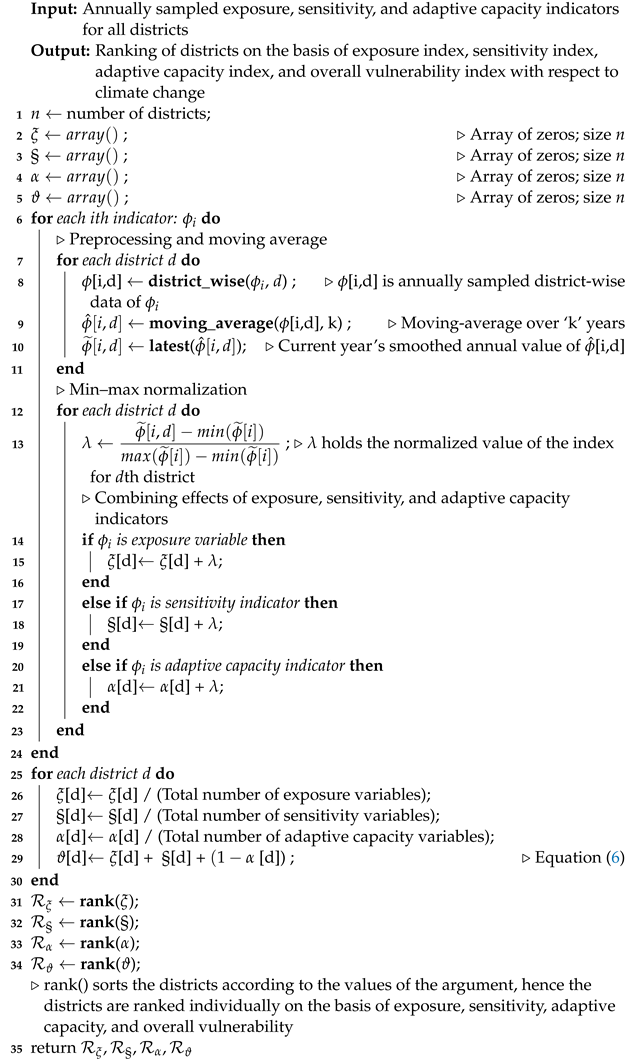 |
3.4. Estimation of the Impact of Climate Change on Agricultural Growth
3.5. Estimation of Climate Variability and Forecasting
4. Results and Discussion
4.1. Estimation of Climate Variability and Forecasting
4.2. Analysis of Exposure of the Studied Region to Climate Change
4.3. Analysis of Sensitivity to Climate Change
4.4. Analysis of Adaptation to Climate Change
4.5. Categorisation of Districts on the Basis of Climate Vulnerability
4.6. Impact of Climate Change and Agricultural Growth Model
5. Conclusions
Author Contributions
Funding
Institutional Review Board Statement
Informed Consent Statement
Data Availability Statement
Conflicts of Interest
Appendix A
Appendix A.1. Test of Auto-Correlation of Residuals (Durbin–Watson Test)
| Ljung–Box (LB) Test | ||||||
|---|---|---|---|---|---|---|
| Lag-value | 1 | 2 | 3 | 4 | 5 | 6 |
| LB statistic | 2.013155 | 2.03636 | 5.550541 | 7.324725 | 7.352519 | 7.353024 |
| LB p-value | 0.155941 | 0.361252 | 0.135647 | 0.119691 | 0.195715 | 0.289429 |
| Lag-value | 7 | 8 | 9 | 10 | 11 | 12 |
| LB statistic | 10.32041 | 10.99063 | 11.23732 | 11.26712 | 12.70028 | 12.88068 |
| LB p-value | 0.171132 | 0.202231 | 0.259792 | 0.337089 | 0.313365 | 0.377773 |
| Lag-value | 13 | 14 | 15 | 16 | 17 | 18 |
| LB statistic | 13.76404 | 14.81549 | 16.67063 | 16.67072 | 16.72562 | 17.02409 |
| LB p-value | 0.390669 | 0.390883 | 0.338932 | 0.407208 | 0.4731 | 0.521449 |
| Lag-value | 19 | 20 | 21 | 22 | 23 | 24 |
| LB statistic | 17.1546 | 17.17511 | 17.5885 | 18.89323 | 18.89363 | 18.94258 |
| LB p-value | 0.579395 | 0.641575 | 0.674875 | 0.651912 | 0.707381 | 0.755045 |
| Lag-value | 25 | 26 | 27 | 28 | 29 | 30 |
| LB Statistic | 20.37629 | 20.54265 | 21.74614 | 22.27702 | 24.35248 | 27.60363 |
| LB p-value | 0.726819 | 0.765169 | 0.750163 | 0.768308 | 0.711367 | 0.591433 |
Appendix A.2. Test of Collinearity (Variance–Inflation Factor Statistic)
| Indicator | Tolerance | Indicator | Tolerance | ||
|---|---|---|---|---|---|
| 0.351 | 2.845 | 0.271 | 3.687 | ||
| 0.977 | 1.023 | 0.665 | 1.503 | ||
| 0.209 | 4.782 | 0.317 | 3.149 | ||
| 0.189 | 5.277 | 0.488 | 2.047 | ||
| 0.242 | 4.126 | 0.205 | 4.87 | ||
| 0.234 | 4.268 | 0.209 | 4.784 | ||
| 0.312 | 3.197 | 0.426 | 2.343 |
Appendix A.3. Test of Normality (Shapiro–Wilk Statistic)
| Indicator | p-Value | Significance | |
|---|---|---|---|
| 0.763 | 0.231 | NS | |
| 0.952 | 0.166 | NS | |
| 0.925 | 0.069 | NS | |
| 0.878 | 0.072 | NS | |
| 0.921 | 0.082 | NS | |
| 0.951 | 0.152 | NS | |
| 0.925 | 0.079 | NS | |
| 0.944 | 0.096 | NS | |
| 0.822 | 0.100 | NS | |
| 0.963 | 0.326 | NS | |
| 0.979 | 0.763 | NS | |
| 0.983 | 0.875 | NS | |
| 0.982 | 0.861 | NS | |
| 0.944 | 0.098 | NS | |
| 0.923 | 0.065 | NS |
Appendix A.4. Test of Homoscedasticity: White Test and Breusch–Pagan–Godfrey Test
| White Test | Breusch–Pagan–Godfrey Test | ||
|---|---|---|---|
| Test statistic | 7.0766 | Lagrange multiplier statistic | 7.9956 |
| Test statistic p-value | 0.2150 | p-value | 0.8895 |
| F-statistic | 1.4764 | F-statistic | 0.4044 |
| F-statistic p-value | 0.2314 | F-statistic p-value | 0.9532 |
References
- Bernstein, L.; Bosch, P.; Canziani, O.; Chen, Z.; Christ, R.; Riahi, K. 2007: Climate Change 2007: Synthesis Report; IPCC: Geneva, Switzerland, 2008. [Google Scholar]
- Staudt, A.; Leidner, A.K.; Howard, J.; Brauman, K.A.; Dukes, J.S.; Hansen, L.J.; Paukert, C.; Sabo, J.; Solórzano, L.A. The added complications of climate change: Understanding and managing biodiversity and ecosystems. Front. Ecol. Environ. 2013, 11, 494–501. [Google Scholar] [CrossRef]
- Maure, D.; Kittel, C.; Lambin, C.; Delhasse, A.; Fettweis, X. Spatially heterogeneous effect of the climate warming on the Arctic land ice. Cryosphere Discuss. 2023, 2023, 1–20. [Google Scholar]
- Arnell, N.W.; Lowe, J.A.; Challinor, A.J.; Osborn, T.J. Global and regional impacts of climate change at different levels of global temperature increase. Clim. Chang. 2019, 155, 377–391. [Google Scholar] [CrossRef] [Green Version]
- Altizer, S.; Ostfeld, R.S.; Johnson, P.T.; Kutz, S.; Harvell, C.D. Climate change and infectious diseases: From evidence to a predictive framework. Science 2013, 341, 514–519. [Google Scholar] [CrossRef] [PubMed] [Green Version]
- Berrang-Ford, L.; Siders, A.; Lesnikowski, A.; Fischer, A.P.; Callaghan, M.W.; Haddaway, N.R.; Mach, K.J.; Araos, M.; Shah, M.A.R.; Wannewitz, M.; et al. A systematic global stocktake of evidence on human adaptation to climate change. Nat. Clim. Chang. 2021, 11, 989–1000. [Google Scholar] [CrossRef]
- Zhang, J.; Shi, K.; Paerl, H.W.; Rühland, K.M.; Yuan, Y.; Wang, R.; Chen, J.; Ge, M.; Zheng, L.; Zhang, Z.; et al. Ancient DNA reveals potentially toxic cyanobacteria increasing with climate change. Water Res. 2023, 229, 119435. [Google Scholar] [CrossRef] [PubMed]
- Adediran, I.A.; Isah, K.O.; Ogbonna, A.E.; Badmus, S.K. A global analysis of the macroeconomic effects of climate change. Asian Econ. Lett. 2023, 4. [Google Scholar] [CrossRef]
- Jha, B.; Tripathi, A. How susceptible Is India’s food basket to climate change? Soc. Chang. 2017, 47, 11–27. [Google Scholar] [CrossRef]
- Bhattacharyya, P.; Pathak, H.; Pal, S.; Bhattacharyya, P.; Pathak, H.; Pal, S. Impact of climate change on agriculture: Evidence and predictions. Clim. Smart Agric. Concepts Chall. Oppor. 2020, 17–32. [Google Scholar]
- World Bank. World Bank Open Data; World Bank: Washington, DC, USA, 2020. [Google Scholar]
- Easterling, W.E.; Aggarwal, P.K.; Batima, P.; Brander, K.M.; Erda, L.; Howden, S.M.; Kirilenko, A.; Morton, J.; Soussana, J.F.; Schmidhuber, J.; et al. Food, fibre and forest products. Clim. Chang. 2007, 2007, 273–313. [Google Scholar]
- Raza, A.; Razzaq, A.; Mehmood, S.S.; Zou, X.; Zhang, X.; Lv, Y.; Xu, J. Impact of climate change on crops adaptation and strategies to tackle its outcome: A review. Plants 2019, 8, 34. [Google Scholar] [CrossRef] [Green Version]
- Kumar, R.; Gautam, H.R. Climate change and its impact on agricultural productivity in India. J. Climatol. Weather. Forecast. 2014, 2, 1–3. [Google Scholar] [CrossRef] [Green Version]
- Malhi, G.S.; Kaur, M.; Kaushik, P. Impact of climate change on agriculture and its mitigation strategies: A review. Sustainability 2021, 13, 1318. [Google Scholar] [CrossRef]
- Akhtar, R.; Masud, M.M. Dynamic linkages between climatic variables and agriculture production in Malaysia: A generalized method of moments approach. Environ. Sci. Pollut. Res. 2022, 29, 41557–41566. [Google Scholar] [CrossRef]
- Jamshidi, O.; Asadi, A.; Kalantari, K.; Azadi, H.; Scheffran, J. Vulnerability to climate change of smallholder farmers in the Hamadan province, Iran. Clim. Risk Manag. 2019, 23, 146–159. [Google Scholar] [CrossRef]
- Fellmann, T. The assessment of climate change-related vulnerability in the agricultural sector: Reviewing conceptual frameworks. Build. Resil. Adapt. Clim. Chang. Agric. Sect. 2012, 23, 37. [Google Scholar]
- Reed, M.; Podesta, G.; Fazey, I.; Geeson, N.; Hessel, R.; Hubacek, K.; Letson, D.; Nainggolan, D.; Prell, C.; Rickenbach, M.; et al. Combining analytical frameworks to assess livelihood vulnerability to climate change and analyse adaptation options. Ecol. Econ. 2013, 94, 66–77. [Google Scholar] [CrossRef] [Green Version]
- IPCC, W. Special report on emissions scenarios. In Intergovernmental Panel on Climate Change Special Reports on Climate Change; Cambridge University Press: Cambridge, UK, 2000; Volume 570. [Google Scholar]
- Anand, V.; Gupta, S.; Gupta, D.; Gulzar, Y.; Xin, Q.; Juneja, S.; Shah, A.; Shaikh, A. Weighted Average Ensemble Deep Learning Model for Stratification of Brain Tumor in MRI Images. Diagnostics 2023, 13, 1320. [Google Scholar] [CrossRef]
- Gulzar, Y.; Khan, S.A. Skin Lesion Segmentation Based on Vision Transformers and Convolutional Neural Networks—A Comparative Study. Appl. Sci. 2022, 12, 5990. [Google Scholar] [CrossRef]
- Khan, S.A.; Gulzar, Y.; Turaev, S.; Peng, Y.S. A modified HSIFT Descriptor for medical image classification of anatomy objects. Symmetry 2021, 13, 1987. [Google Scholar] [CrossRef]
- Alam, S.; Raja, P.; Gulzar, Y. Investigation of Machine Learning Methods for Early Prediction of Neurodevelopmental Disorders in Children. Wirel. Commun. Mob. Comput. 2022, 2022, 5766386. [Google Scholar] [CrossRef]
- Sahlan, F.; Hamidi, F.; Misrat, M.Z.; Adli, M.H.; Wani, S.; Gulzar, Y. Prediction of Mental Health Among University Students. Int. J. Perceptive Cogn. Comput. 2021, 7, 85–91. [Google Scholar]
- Dhanya, V.; Subeesh, A.; Kushwaha, N.; Vishwakarma, D.K.; Kumar, T.N.; Ritika, G.; Singh, A. Deep learning based computer vision approaches for smart agricultural applications. Artif. Intell. Agric. 2022, 6, 211–229. [Google Scholar] [CrossRef]
- Gulzar, Y. Fruit Image Classification Model Based on MobileNetV2 with Deep Transfer Learning Technique. Sustainability 2023, 15, 1906. [Google Scholar] [CrossRef]
- Yang, B.; Xu, Y. Applications of deep-learning approaches in horticultural research: A review. Hortic. Res. 2021, 8, 123. [Google Scholar] [CrossRef]
- Igried, B.; AlZu’bi, S.; Aqel, D.; Mughaid, A.; Ghaith, I.; Abualigah, L. An Intelligent and Precise Agriculture Model in Sustainable Cities Based on Visualized Symptoms. Agriculture 2023, 13, 889. [Google Scholar] [CrossRef]
- Ayoub, S.; Gulzar, Y.; Rustamov, J.; Jabbari, A.; Reegu, F.A.; Turaev, S. Adversarial Approaches to Tackle Imbalanced Data in Machine Learning. Sustainability 2023, 15, 7097. [Google Scholar] [CrossRef]
- Bali, N.; Singla, A. Emerging Trends in Machine Learning to Predict Crop Yield and Study Its Influential Factors: A Survey; Springer: Berlin/Heidelberg, Germany, 2022; pp. 1–18. [Google Scholar]
- Aggarwal, S.; Gupta, S.; Gupta, D.; Gulzar, Y.; Juneja, S.; Alwan, A.A.; Nauman, A. An Artificial Intelligence-Based Stacked Ensemble Approach for Prediction of Protein Subcellular Localization in Confocal Microscopy Images. Sustainability 2023, 15, 1695. [Google Scholar] [CrossRef]
- Mekhilef, S.; Saidur, R.; Kamalisarvestani, M. Effect of dust, humidity and air velocity on efficiency of photovoltaic cells. Renew. Sustain. Energy Rev. 2012, 16, 2920–2925. [Google Scholar] [CrossRef]
- Nie, H.; Han, X.; He, B.; Sun, L.; Chen, B.; Zhang, W.; Wu, S.; Kong, H. Deep sequence-to-sequence entity matching for heterogeneous entity resolution. In Proceedings of the 28th ACM International Conference on Information and Knowledge Management, Beijing, China, 3–7 November 2019; pp. 629–638. [Google Scholar]
- Crane-Droesch, A. Machine learning methods for crop yield prediction and climate change impact assessment in agriculture. Environ. Res. Lett. 2018, 13, 114003. [Google Scholar] [CrossRef] [Green Version]
- Alibabaei, K.; Gaspar, P.D.; Lima, T.M. Crop yield estimation using deep learning based on climate big data and irrigation scheduling. Energies 2021, 14, 3004. [Google Scholar] [CrossRef]
- Directorate of Economics and Statistics, Planning Development & Monitoring Department (Government of Jammu & Kashmir), Digest of Statistics. Available online: https://ecostatjk.nic.in/ (accessed on 11 January 2023).
- NASA Langley Research Center (LaRC), Prediction Of Worldwide Energy Resources (POWER). Available online: https://power.larc.nasa.gov (accessed on 14 January 2023).
- Meinshausen, M.; Lewis, J.; McGlade, C.; Gütschow, J.; Nicholls, Z.; Burdon, R.; Cozzi, L.; Hackmann, B. Realization of Paris Agreement pledges may limit warming just below 2 C. Nature 2022, 604, 304–309. [Google Scholar] [CrossRef] [PubMed]
- Yin, J. Rapid Decadal Acceleration of Sea Level Rise along the US East and Gulf Coasts during 2010–2022 and Its Impact on Hurricane-Induced Storm Surge. J. Clim. 2023, 36, 4511–4529. [Google Scholar] [CrossRef]
- Konapala, G.; Mishra, A.K.; Wada, Y.; Mann, M.E. Climate change will affect global water availability through compounding changes in seasonal precipitation and evaporation. Nat. Commun. 2020, 11, 3044. [Google Scholar] [CrossRef]
- Allan, R.P.; Barlow, M.; Byrne, M.P.; Cherchi, A.; Douville, H.; Fowler, H.J.; Gan, T.Y.; Pendergrass, A.G.; Rosenfeld, D.; Swann, A.L.; et al. Advances in understanding large-scale responses of the water cycle to climate change. Ann. N. Y. Acad. Sci. 2020, 1472, 49–75. [Google Scholar] [CrossRef] [Green Version]
- Mahato, A. Climate change and its impact on agriculture. Int. J. Sci. Res. Publ. 2014, 4, 1–6. [Google Scholar]
- Sun, Z.; Wang, C. Impact of changing climate on agriculture in China. Sci. Technol. Rev. 2010, 28, 110–117. [Google Scholar]
- Singh, P.; Kumar, V.; Thomas, T.; Arora, M. Changes in rainfall and relative humidity in river basins in northwest and central India. Hydrol. Process. Int. J. 2008, 22, 2982–2992. [Google Scholar] [CrossRef]
- Chaudhry, S.; Sidhu, G.P.S. Climate change regulated abiotic stress mechanisms in plants: A comprehensive review. Plant Cell Rep. 2022, 41, 1–31. [Google Scholar] [CrossRef]
- Ceccarelli, S.; Grando, S.; Maatougui, M.; Michael, M.; Slash, M.; Haghparast, R.; Rahmanian, M.; Taheri, A.; Al-Yassin, A.; Benbelkacem, A.; et al. Plant breeding and climate changes. J. Agric. Sci. 2010, 148, 627–637. [Google Scholar] [CrossRef]
- Sharma, V.; Khatri, R.; Alok, G. Impact of global warming and climate change on environment, seribiodiversity and human health in India. Life Sci. Bull. 2011, 8, 205–210. [Google Scholar]
- Dhiman, R.C.; Pahwa, S.; Dhillon, G.; Dash, A.P. Climate change and threat of vector-borne diseases in India: Are we prepared? Parasitol. Res. 2010, 106, 763–773. [Google Scholar] [CrossRef] [PubMed]
- van Beek, C.L.; Meerburg, B.G.; Schils, R.L.; Verhagen, J.; Kuikman, P.J. Feeding the world’s increasing population while limiting climate change impacts: Linking N2O and CH4 emissions from agriculture to population growth. Environ. Sci. Policy 2010, 13, 89–96. [Google Scholar] [CrossRef]
- Bindi, M.; Olesen, J.E. The responses of agriculture in Europe to climate change. Reg. Environ. Chang. 2011, 11, 151–158. [Google Scholar] [CrossRef]
- Eisenack, K.; Tekken, V.; Kropp, J. Stakeholder Perceptions of climate change in the Baltic Sea Region. Coastline Rep. 2007, 8, 245–255. [Google Scholar]
- Fiorino, D.J. Climate change and right-wing populism in the United States. Environ. Politics 2022, 31, 801–819. [Google Scholar] [CrossRef]
- Chauhan, B.S.; Prabhjyot-Kaur; Mahajan, G.; Randhawa, R.K.; Singh, H.; Kang, M.S. Global warming and its possible impact on agriculture in India. Adv. Agron. 2014, 123, 65–121. [Google Scholar]
- Hatfield, J.L.; Boote, K.J.; Kimball, B.A.; Ziska, L.; Izaurralde, R.C.; Ort, D.; Thomson, A.M.; Wolfe, D. Climate impacts on agriculture: Implications for crop production. Agron. J. 2011, 103, 351–370. [Google Scholar] [CrossRef] [Green Version]
- Longobardi, P.; Montenegro, A.; Beltrami, H.; Eby, M. Deforestation induced climate change: Effects of spatial scale. PLoS ONE 2016, 11, e0153357. [Google Scholar] [CrossRef] [Green Version]
- Williams, R.G.; Roussenov, V.; Goodwin, P.; Resplandy, L.; Bopp, L. Sensitivity of global warming to carbon emissions: Effects of heat and carbon uptake in a suite of Earth system models. J. Clim. 2017, 30, 9343–9363. [Google Scholar] [CrossRef] [Green Version]
- Jat, N.; Mazumdar, S.; Gajanand, J. Agriculture: A contributor and victim of climate change. Indian J. Fertil. 2011, 7, 124–136. [Google Scholar]
- Lal, M.; Singh, K.; Rathore, L.; Srinivasan, G.; Saseendran, S. Vulnerability of rice and wheat yields in NW India to future changes in climate. Agric. For. Meteorol. 1998, 89, 101–114. [Google Scholar] [CrossRef]
- Mall, R.K.; Aggarwal, P. Climate change and rice yields in diverse agro-environments of India. I. Evaluation of impact assessment models. Clim. Chang. 2002, 52, 315–330. [Google Scholar] [CrossRef]
- Attri, S.; Rathore, L. Simulation of impact of projected climate change on wheat in India. Int. J. Climatol. J. R. Meteorol. Soc. 2003, 23, 693–705. [Google Scholar] [CrossRef]
- Strzepek, K.; Boehlert, B. Competition for water for the food system. Philos. Trans. R. Soc. Biol. Sci. 2010, 365, 2927–2940. [Google Scholar] [CrossRef] [PubMed]
- Guiteras, R. The Impact of Climate Change on Indian Agriculture; Department of Economics, University of Maryland: College Park, MD, USA, 2009. [Google Scholar]
- O’brien, K.; Eriksen, S.; Nygaard, L.P.; Schjolden, A. Why different interpretations of vulnerability matter in climate change discourses. Clim. Policy 2007, 7, 73–88. [Google Scholar] [CrossRef]
- Schilling, J.; Hertig, E.; Tramblay, Y.; Scheffran, J. Climate change vulnerability, water resources and social implications in North Africa. Reg. Environ. Chang. 2020, 20, 1–12. [Google Scholar] [CrossRef] [Green Version]
- Huang, T.; Hsu, Y.; Chou, Y. Influence of climate change on the incidence of rice diseases and our adaptive strategies. Plant Prot. Bull. 2010, 52, 25–42. [Google Scholar]
- Yohannes, H. A review on relationship between climate change and agriculture. J. Earth Sci. Clim. Chang. 2016, 7, 335. [Google Scholar]
- Thathsarani, U.; Gunaratne, L. Constructing and index to measure the adaptive capacity to climate change in Sri Lanka. Procedia Eng. 2018, 212, 278–285. [Google Scholar] [CrossRef]
- Wall, E.; Smit, B. Climate change adaptation in light of sustainable agriculture. J. Sustain. Agric. 2005, 27, 113–123. [Google Scholar] [CrossRef]
- Quiggin, J. Agriculture and global climate stabilization: A public good analysis. Agric. Econ. 2010, 41, 121–132. [Google Scholar] [CrossRef] [Green Version]
- Wang, H.; Li, H.; Fang, J.; Wang, H. Robust Gaussian Kalman Filter With Outlier Detection. IEEE Signal Process. Lett. 2018, 25, 1236–1240. [Google Scholar] [CrossRef]
- Mendelsohn, R.; Nordhaus, W.D.; Shaw, D. The impact of global warming on agriculture: A Ricardian analysis. Am. Econ. Rev. 1994, 84, 753–771. [Google Scholar]
- Greff, K.; Srivastava, R.K.; Koutník, J.; Steunebrink, B.R.; Schmidhuber, J. LSTM: A search space odyssey. IEEE Trans. Neural Netw. Learn. Syst. 2016, 28, 2222–2232. [Google Scholar] [CrossRef] [Green Version]
- Lu, Y.; Lu, J. A universal approximation theorem of deep neural networks for expressing probability distributions. Adv. Neural Inf. Process. Syst. 2020, 33, 3094–3105. [Google Scholar]
- Khiatani, D.; Ghose, U. Weather forecasting using Hidden Markov Model. In Proceedings of the 2017 International Conference on Computing and Communication Technologies for Smart Nation (IC3TSN), Gurgaon, India, 12–14 October 2017; pp. 220–225. [Google Scholar] [CrossRef]
- Box, G.E.; Jenkins, G.M.; Reinsel, G.C.; Ljung, G.M. Time Series Analysis: Forecasting and Control; John Wiley & Sons: Hoboken, NJ, USA, 2015. [Google Scholar]
- Ostertagová, E.; Ostertag, O. The simple exponential smoothing model. In Proceedings of the The 4th International Conference on Modelling of Mechanical and Mechatronic Systems, Technical University of Košice, Slovak Republic, Proceedings of Conference, Vysoke Tatry, Slovakia, 25–27 November 2011; pp. 380–384. [Google Scholar]
- Gardner Jr, E.S. Exponential smoothing: The state of the art—Part II. Int. J. Forecast. 2006, 22, 637–666. [Google Scholar] [CrossRef]
- Amari, S.i. Backpropagation and stochastic gradient descent method. Neurocomputing 1993, 5, 185–196. [Google Scholar] [CrossRef]
- Goodfellow, I.; Bengio, Y.; Courville, A.; Bengio, Y. Deep Learning; MIT Press: Cambridge, UK, 2016; Volume 1. [Google Scholar]
- Woolway, R.I.; Weyhenmeyer, G.A.; Schmid, M.; Dokulil, M.T.; de Eyto, E.; Maberly, S.C.; May, L.; Merchant, C.J. Substantial increase in minimum lake surface temperatures under climate change. Clim. Chang. 2019, 155, 81–94. [Google Scholar] [CrossRef] [Green Version]
- Neelin, J.D.; Sahany, S.; Stechmann, S.N.; Bernstein, D.N. Global warming precipitation accumulation increases above the current-climate cutoff scale. Proc. Natl. Acad. Sci. USA 2017, 114, 1258–1263. [Google Scholar] [CrossRef]
- McNabb, D.E.; Swenson, C.R. FromWater Stress to aWater Crisis. In America’s Water Crises: The Impact of Drought and Climate Change; Springer: Cham, Switzerland, 2023; pp. 29–53. [Google Scholar] [CrossRef]
- Sarker, M.A.R.; Alam, K.; Gow, J. Assessing the effects of climate change on rice yields: An econometric investigation using Bangladeshi panel data. Econ. Anal. Policy 2014, 44, 405–416. [Google Scholar] [CrossRef]
- Challinor, A.J.; Parkes, B.; Ramirez-Villegas, J. Crop yield response to climate change varies with cropping intensity. Glob. Chang. Biol. 2015, 21, 1679–1688. [Google Scholar] [CrossRef] [PubMed] [Green Version]
- McMichael, A.J.; Powles, J.W.; Butler, C.D.; Uauy, R. Food, livestock production, energy, climate change, and health. Lancet 2007, 370, 1253–1263. [Google Scholar] [CrossRef] [PubMed]
- Escoz-Roldán, A.; Gutiérrez-Pérez, J.; Meira-Cartea, P.Á. Water and climate change, two key objectives in the agenda 2030: Assessment of climate literacy levels and social representations in academics from three climate contexts. Water 2019, 12, 92. [Google Scholar] [CrossRef] [Green Version]
- Smith, W.; Grant, B.; Desjardins, R.; Kroebel, R.; Li, C.; Qian, B.; Worth, D.; McConkey, B.; Drury, C. Assessing the effects of climate change on crop production and GHG emissions in Canada. Agric. Ecosyst. Environ. 2013, 179, 139–150. [Google Scholar] [CrossRef]
- Shapiro, S.S.; Wilk, M.B. An analysis of variance test for normality (complete samples). Biometrika 1965, 52, 591–611. [Google Scholar] [CrossRef]
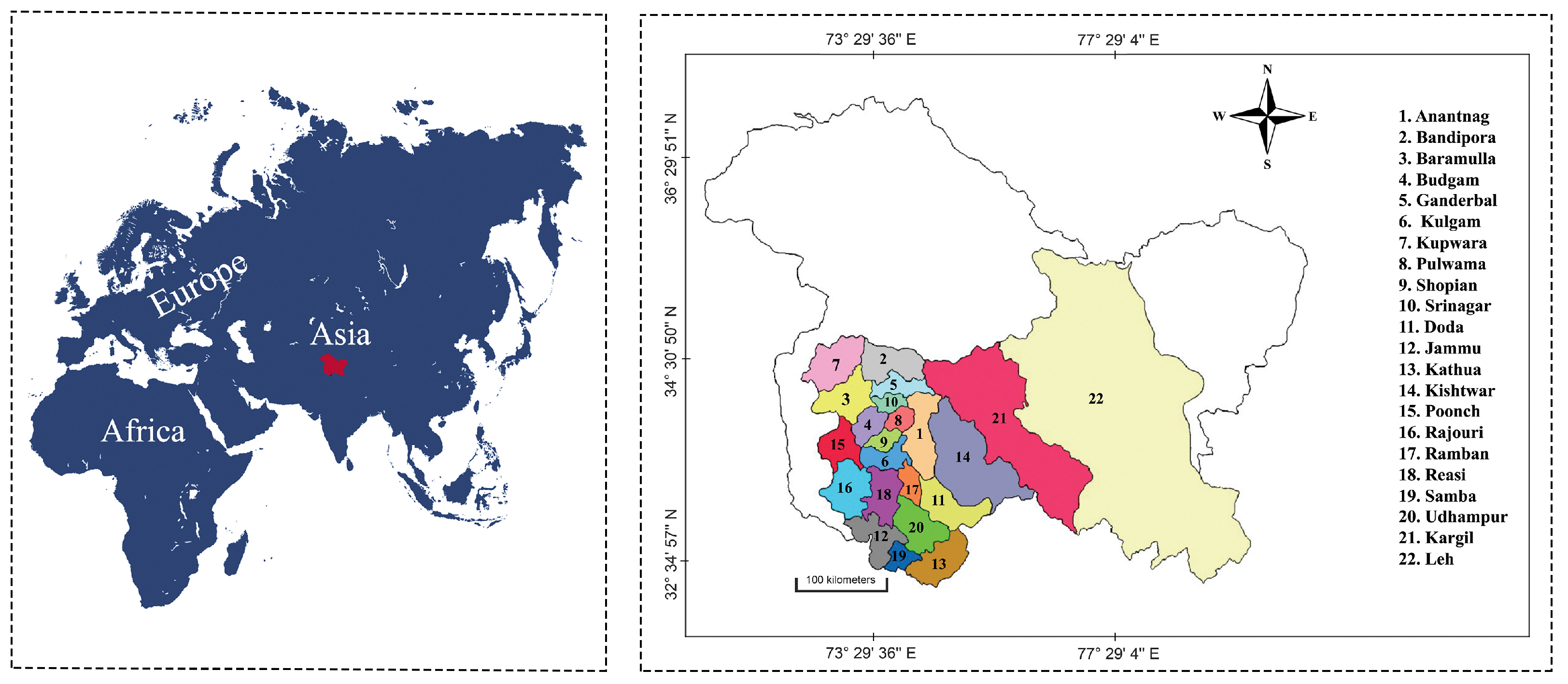


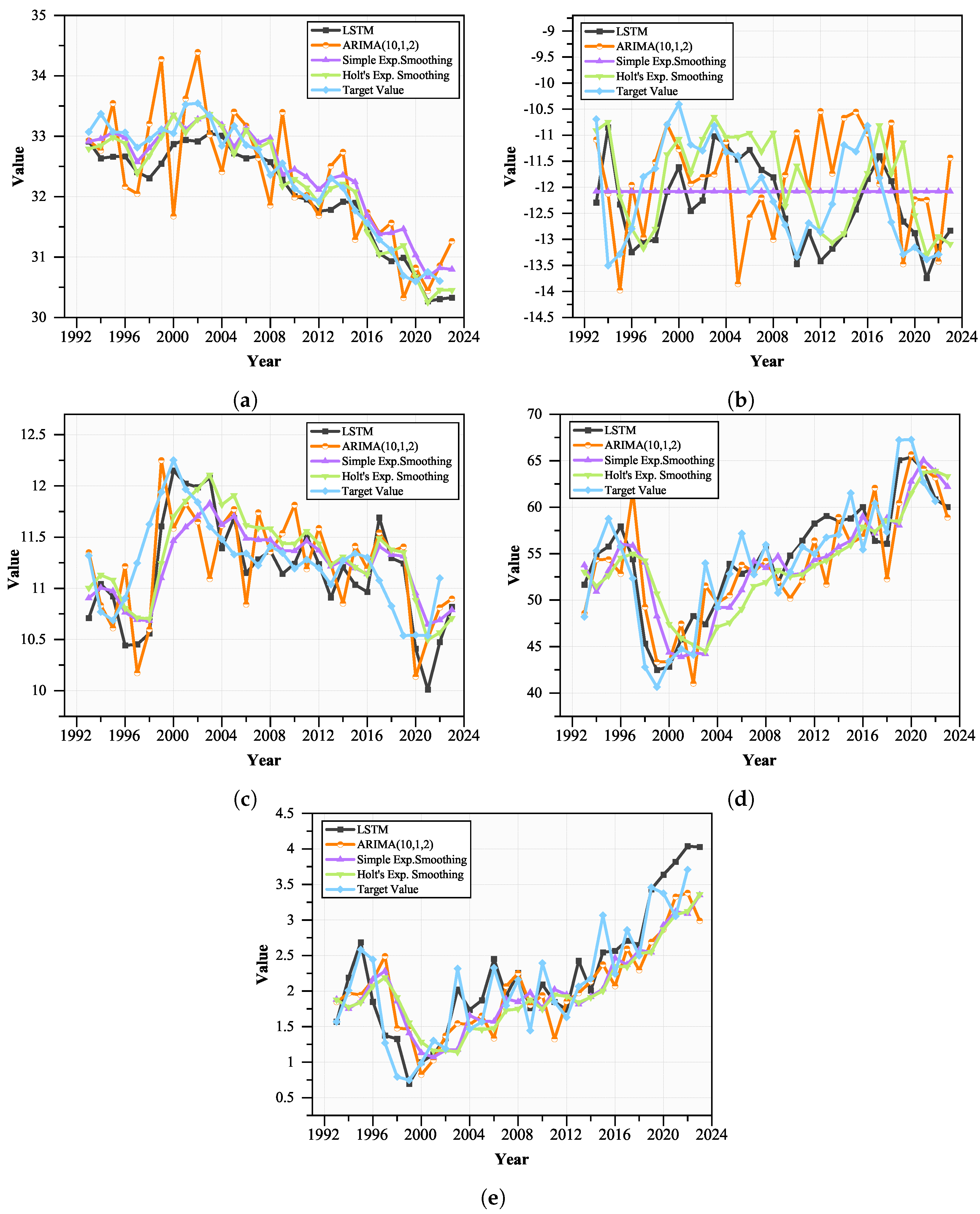
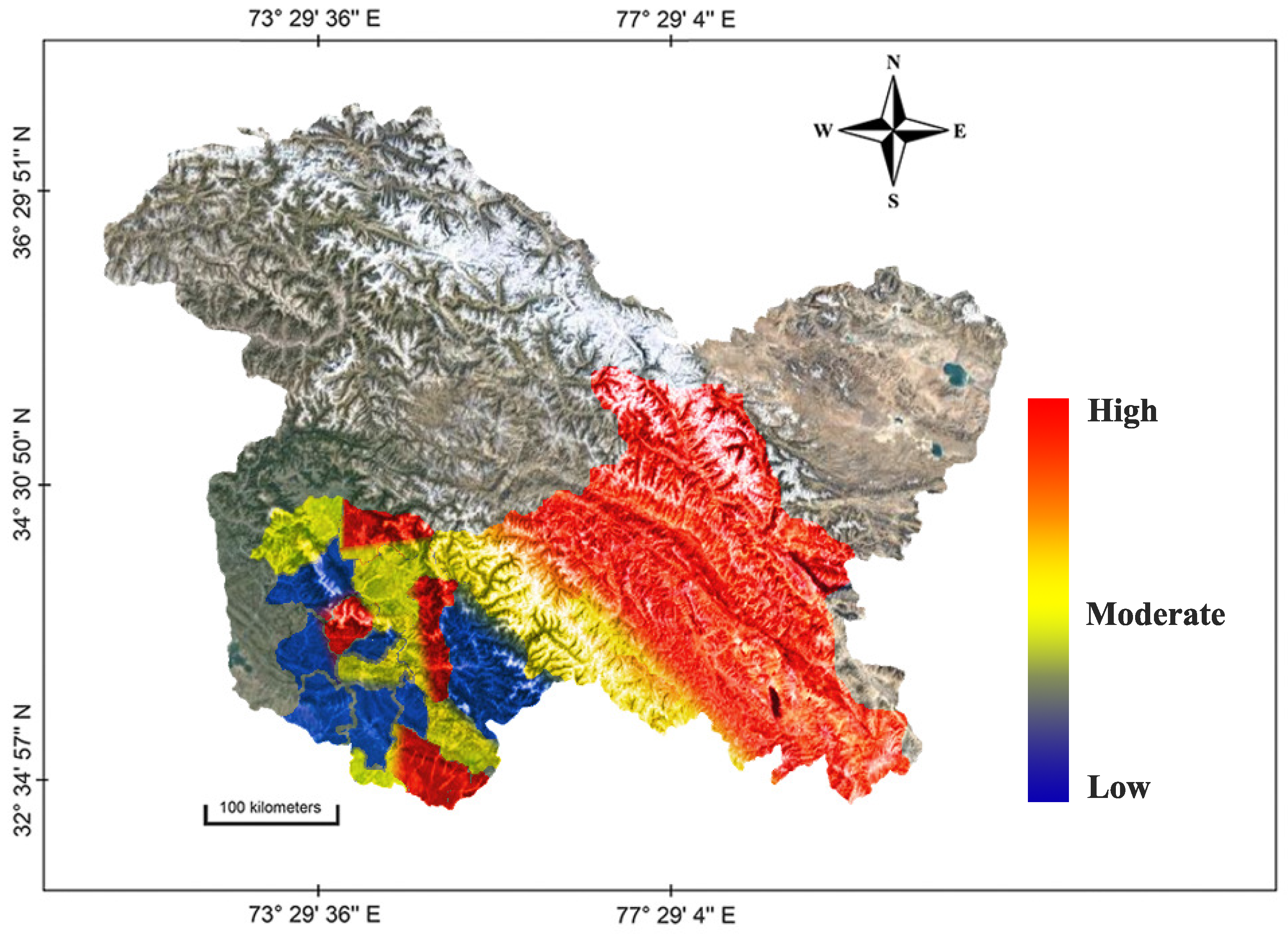
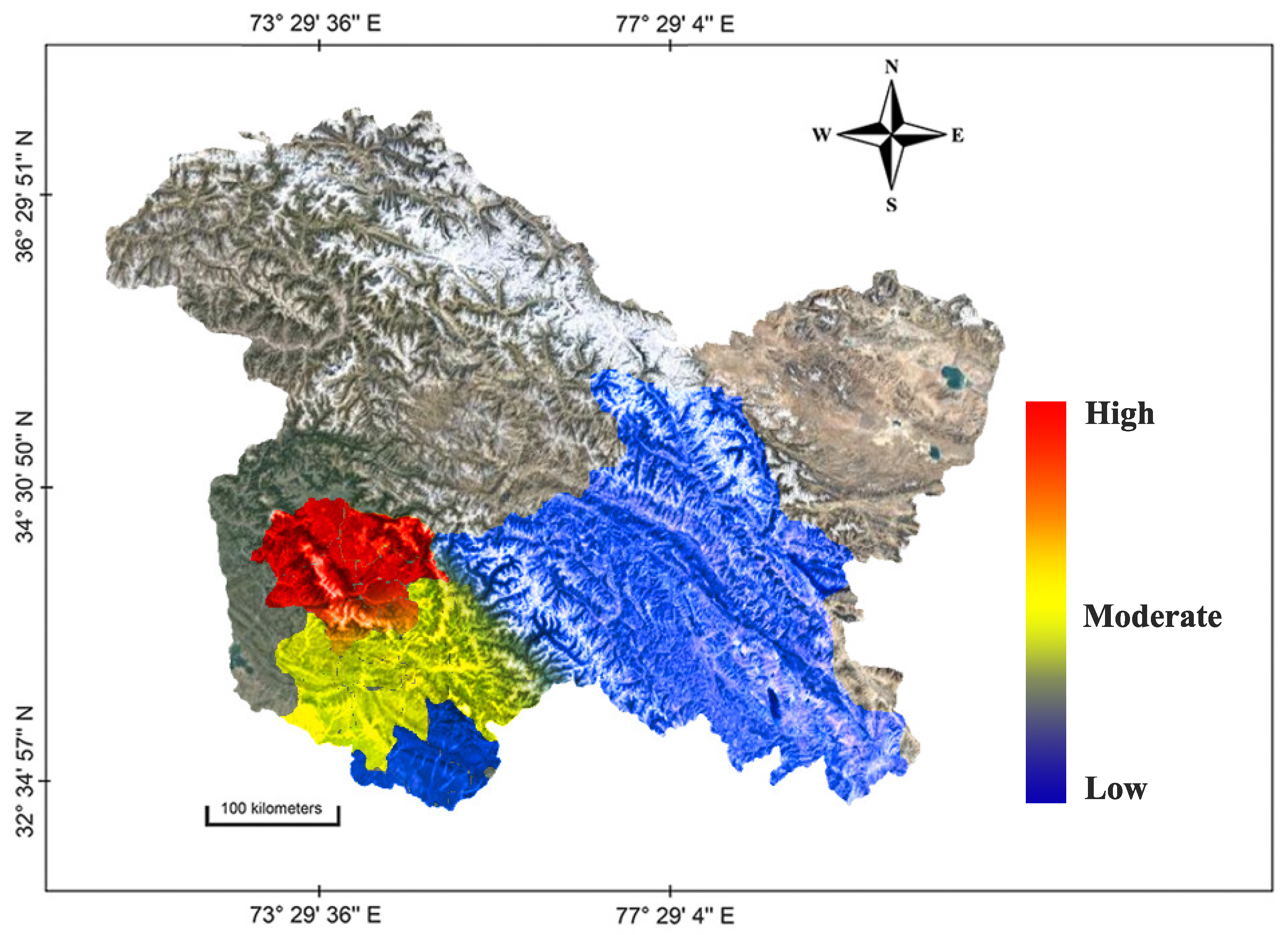
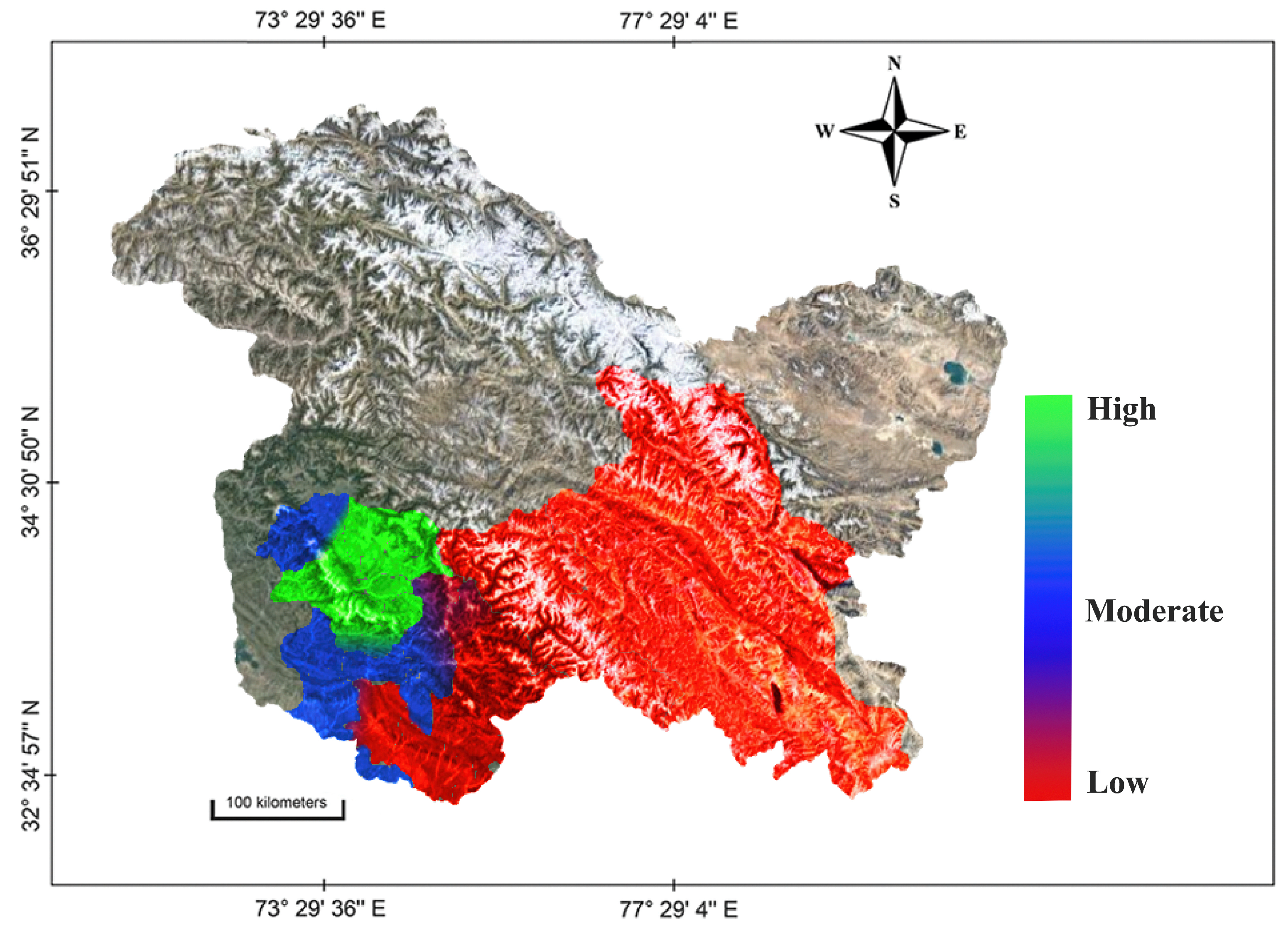
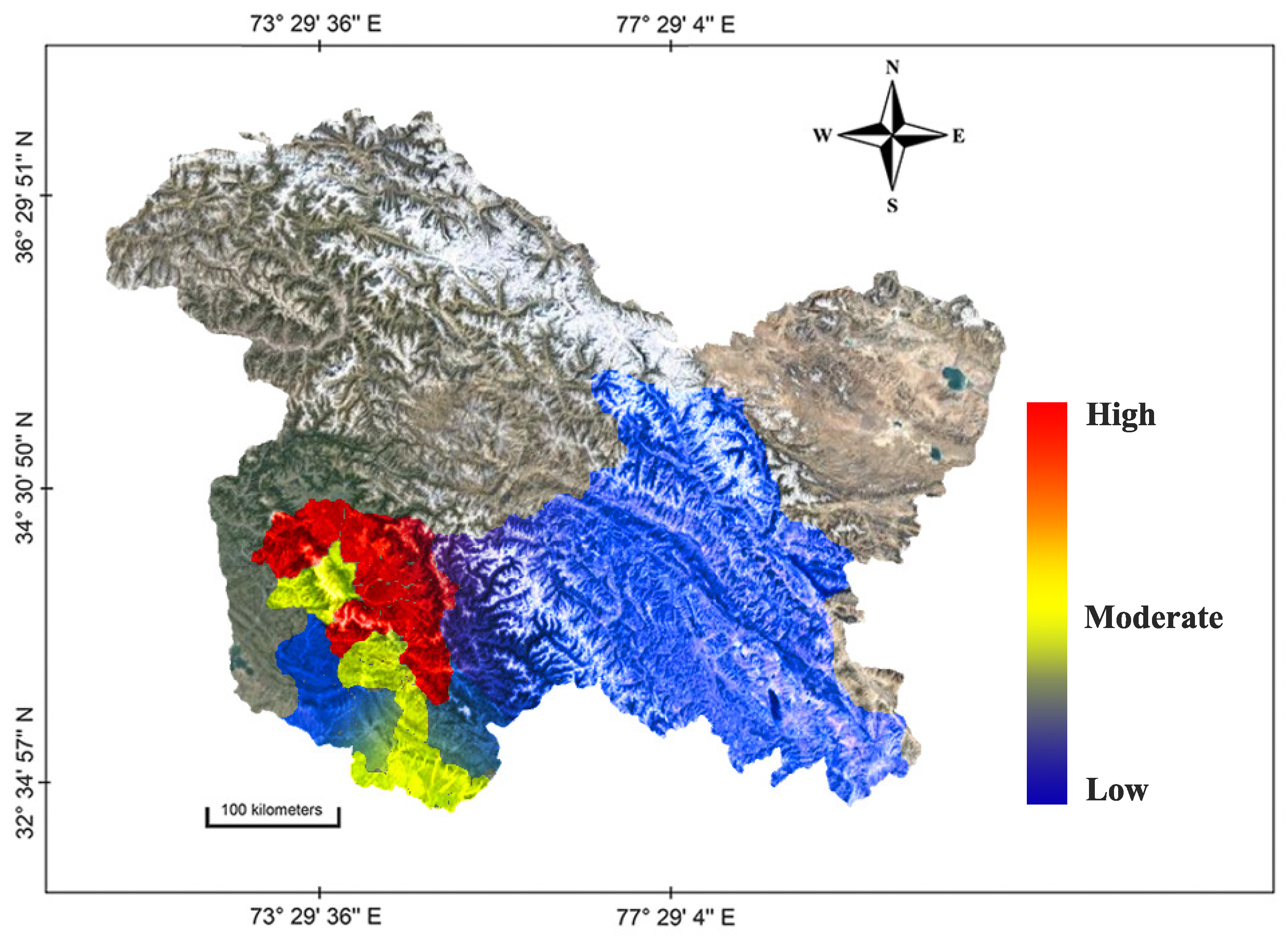
| District | Lat., Long. | District | Lat., Long. |
|---|---|---|---|
| Anantnag | 33 49 N, 75 15 E | Jammu | 32 44 N , 74 51 E |
| Bandipora | 34 25 N, 74 38 E | Kathua | 32 35 N , 75 37 E |
| Baramulla | 34 10 N, 74 22 E | Kishtwar | 33 19 N , 75 46 E |
| Budgam | 33 55 N, 74 38 E | Poonch | 33 42 N , 74 15 E |
| Ganderbal | 34 13 N, 74 47 E | Rajouri | 33 16 N , 74 21 E |
| Kulgam | 33 39 N, 75 0 E | Ramban | 33 20 N , 75 12 E |
| Kupwara | 34 31 N, 74 11 E | Reasi | 33 4 N , 74 50 E |
| Pulwama | 33 57 N, 75 3 E | Samba | 32 35 N , 75 7 E |
| Shopian | 33 49 N, 74 50 E | Udhampur | 32 55 N , 75 20 E |
| Srinagar | 34 5 N, 74 48 E | Kargil | 33 48 N , 76 28 E |
| Doda | 33 8 N, 75 35 E | Leh | 33 21 N , 78 15 E |
| Components | Indicators (unit) | Representation | Func. Rel. |
|---|---|---|---|
| EXPOSURE | Annual precipitation (mm) Change in annual precipitation (%) | + | |
| Annual maximum temperature ( C) Change in annual maximum temperature (%) | + | ||
| Annual minimum temperature ( C) Change in annual maximum temperature (%) | + | ||
| Annual average temperature ( C) Change in annual average temperature (%) | + | ||
| Annual relative humidity (%) | + | ||
| SENSITIVITY | Average land holding size (hectares) | + | |
| Culturable waste land (% reported area) | + | ||
| Gross irrigated area (% total sown area) | + | ||
| Net irrigated area (% net sown area) | + | ||
| Area under apple (% total fruit area) | + | ||
| Area under major food crops (% Total sown area) | + | ||
| Area under rice (% total sown area) | + | ||
| Agricultural workers (% total workers) | + | ||
| Agricultural labourers (% agricultural workers) | + | ||
| Population density (number per ) | + | ||
| Illiteracy rate (%) | + | ||
| BPL population (% total population) | + | ||
| ADAPTIVE CAPACITY | Net sown area (% reported area) | − | |
| Forest area (% reported area) | − | ||
| Area under all food crops (% total sown area) | − | ||
| Area under fruit crops (% geographical area) | − | ||
| Area under walnut (% total fruit area) | − | ||
| Total fodder area (% total sown area) | − | ||
| Cropping intensity (%) | − | ||
| Irrigation intensity (%) | − | ||
| Villages electrified (%) | − | ||
| Cultivators (% agricultural workers) | − | ||
| Total workers (% total population) | − | ||
| Livestock density (number per ) | − | ||
| Fish caught (quintals) | − | ||
| Rationed population (% total population) | − | ||
| Literacy rate (%) | − | ||
| Bank branches (number per lakh hectares of net sown area) | − | ||
| Credit societies (number per thousand hectares of net sown area) | − | ||
| Health institutions (number per lakh population) | − | ||
| Welfare centres (number per lakh population) | − | ||
| Liveable houses (% total houses) | − |
| Indicators (Unit) | Representation |
|---|---|
| Net irrigated land (% net sown area) * | |
| Cropping intensity (%) * | |
| Tractors (number per thousand hectares of total sown area) | |
| Tubewells energized (number per thousand hectares of total sown area) | |
| Rural literacy rate (%) | |
| Average land holding (hectares) * | |
| Public investment in agriculture (rupees per hectare) | |
| Agricultural credit (direct credit per hectare) | |
| Variance in maximum temperature (%) * | |
| Variance in minimum temperature (%) * | |
| Variance in precipitation (%) * | |
| Change in annual maximum temperature (%) * | |
| Change in annual minimum temperature (%) * | |
| Change in annual precipitation (%) * |
| Hyper-Parameters | Space |
|---|---|
| Optimizer | Adam |
| Learning rate | [0.01, 0.1] |
| Baseline | 1 LSTM layer, 4 LSTM cells |
| Fully connected layers | 2 |
| Regularization | 60% Dropout on LSTM output |
| Input dimensions | 10 × 1 |
| Output dimensions | 1 × 1 |
| Generalization loss | Mean squared error (MSE) |
| Epochs | [50, 100, 200, 300, 500] |
| Batch size | [8, 16, 32] |
| Convergence | Early stopping |
| Model (→) Name of Variable (↓) | LSTM | ARIMA (10,1,2) | SES | HES |
|---|---|---|---|---|
| RMSE | ||||
| 0.293801 | 0.488456 | 0.552951 | 0.567089 | |
| 2.602121 | 3.55365 | 4.611147 | 4.955605 | |
| 0.413821 | 0.455526 | 0.399482 | 0.412566 | |
| 0.293187 | 0.539785 | 0.307205 | 0.298067 | |
| 0.974485 | 1.057636 | 0.948449 | 1.038631 | |
| MAE | ||||
| 0.230967667 | 0.38846 | 0.441161 | 0.442889 | |
| 2.129080667 | 2.854096 | 3.588261 | 3.975286 | |
| 0.324114 | 0.357876 | 0.316091 | 0.347007 | |
| 0.240407 | 0.432585 | 0.250983 | 0.249933 | |
| 0.771305333 | 0.821572 | 0.844976 | 0.816885 | |
| Coefficient (Indicator) | Value | Standard Error | Coefficient (Indicator) | Value | Standard Error |
|---|---|---|---|---|---|
| 17.075 | 4.039 | () | 0.037 * | 0.012 | |
| () | 0.225 * | 0.058 | () | 0.325 * | 0.104 |
| () | 0.052 * | 0.014 | () | −0.499 | 0.458 |
| () | 0.008 | 0.026 | () | −0.189 * | 0.066 |
| 0.026 | 0.104 | () | −0.170 * | 0.079 | |
| () | 0.070 * | 0.024 | () | 0.010 | 0.007 |
| () | −2.268 * | 0.030 | () | −0.011 * | 0.004 |
| () | 0.001 | 0.001 | |||
| R | 0.879 |
Disclaimer/Publisher’s Note: The statements, opinions and data contained in all publications are solely those of the individual author(s) and contributor(s) and not of MDPI and/or the editor(s). MDPI and/or the editor(s) disclaim responsibility for any injury to people or property resulting from any ideas, methods, instructions or products referred to in the content. |
© 2023 by the authors. Licensee MDPI, Basel, Switzerland. This article is an open access article distributed under the terms and conditions of the Creative Commons Attribution (CC BY) license (https://creativecommons.org/licenses/by/4.0/).
Share and Cite
Malik, I.; Ahmed, M.; Gulzar, Y.; Baba, S.H.; Mir, M.S.; Soomro, A.B.; Sultan, A.; Elwasila, O. Estimation of the Extent of the Vulnerability of Agriculture to Climate Change Using Analytical and Deep-Learning Methods: A Case Study in Jammu, Kashmir, and Ladakh. Sustainability 2023, 15, 11465. https://doi.org/10.3390/su151411465
Malik I, Ahmed M, Gulzar Y, Baba SH, Mir MS, Soomro AB, Sultan A, Elwasila O. Estimation of the Extent of the Vulnerability of Agriculture to Climate Change Using Analytical and Deep-Learning Methods: A Case Study in Jammu, Kashmir, and Ladakh. Sustainability. 2023; 15(14):11465. https://doi.org/10.3390/su151411465
Chicago/Turabian StyleMalik, Irtiqa, Muneeb Ahmed, Yonis Gulzar, Sajad Hassan Baba, Mohammad Shuaib Mir, Arjumand Bano Soomro, Abid Sultan, and Osman Elwasila. 2023. "Estimation of the Extent of the Vulnerability of Agriculture to Climate Change Using Analytical and Deep-Learning Methods: A Case Study in Jammu, Kashmir, and Ladakh" Sustainability 15, no. 14: 11465. https://doi.org/10.3390/su151411465
APA StyleMalik, I., Ahmed, M., Gulzar, Y., Baba, S. H., Mir, M. S., Soomro, A. B., Sultan, A., & Elwasila, O. (2023). Estimation of the Extent of the Vulnerability of Agriculture to Climate Change Using Analytical and Deep-Learning Methods: A Case Study in Jammu, Kashmir, and Ladakh. Sustainability, 15(14), 11465. https://doi.org/10.3390/su151411465







